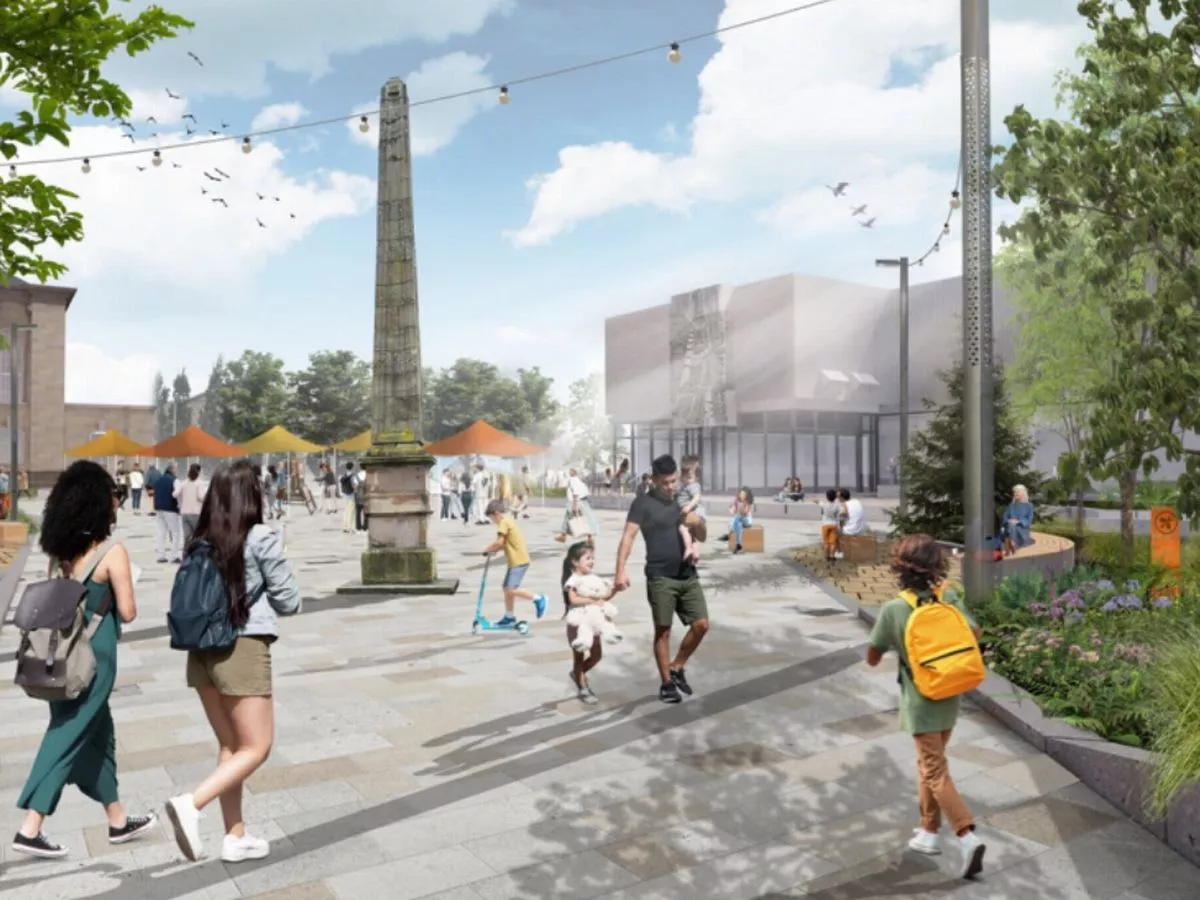Copyright manchestereveningnews

Eleven new developments are set to transform Wigan with a total of £1bn to be spent in the town until 2028. Incorporated into the borough, created under local government reorganisation in 1974, are its largest town centres, including Wigan , Leigh and Ashton in Makerfield. However, there are other important, albeit smaller, satellite towns, such as Tyldesley, Atherton, Hindley, Orrell, and, of course, the villages of Standish, Golborne and Shevington, to consider. To see planning applications; traffic and road diversions and layout changes; and more, visit the Public Notices Portal HERE The mind boggles when it’s taken into account that £1bn of inward investment will have come into all corners of what we know as Wigan Metropolitan Borough by 2028, as town hall bosses bid to balance the demands for major regeneration projects across the entire administrative area. A report to the council’s place and environment scrutiny committee to be delivered next week (Wednesday November 12) gives an insightful update on the progress of various projects currently underway, funded largely by money from central government. Authored by the director of place Aiden Thatcher, it highlights the ‘significant progress’ in enabling ‘transformational town centre projects’ to come to fruition. It also alludes to growing momentum behind ‘Northfold’ - the growth area spanning Wigan and Bolton , which is one of six such zones in Greater Manchester, and the need for the long-talked-about east-west link road between the M6 and M61. The key driver behind all this is something called the Local Plan which is currently in its draft form and is due to be reported to the council’s cabinet this month. A Local Plan, which all planning authorities across England are required by law to have, serves as the overarching policy framework for land use. It establishes policies across a wide range of issues, including housing, employment, the environment, and regeneration, among others. Mr Thatcher’s report focuses on two projects now ‘making great strides forward’ thanks to successful competitive bids to the government’s Levelling Up Fund - now known as the Local Regeneration Fund - now taking place in Leigh and Ashton town centres. But there are a total of 11 important projects taking place across the borough, so let’s deal with them one by one. Formerly known as The Galleries, this is a major redevelopment taking place in Wigan town centre. It will consist of a new Market Hall - to be open within the next 12 months - a hotel, flexible office ‘Pavilion’ building, multi-media centre and 450 homes as well as a new public square. The council is working closely with Cityheart and Galliford Try to ensure that ‘all aspects of social value targets’ are met. So far, £5m has been spent locally and numerous jobs have been created. Formerly known as Eckersley Mill, Cotton Works is a 16-acre brownfield site on the southern edge of Wigan town centre in the Wigan Pier Quarter and conservation area. It will be a ‘destination neighbourhood’ for Wigan - a place to live, work, trade, shop, eat and drink. Grade II-listed mill architecture will be enhanced and there will be more than 800 new homes and 152,000 sqft of office space and 92,100 sqft of commercial/leisure space, in addition to a 120-room hotel, a retirement living scheme and landscaped spaces. The Heaton Group recently completed the mixed-use redevelopment of Mill 1, including a new food hall and pub (The Three Mills) and has relocated its headquarters there. Block A is the company’s next priority as apart of its phased masterplan, subject to a recent funding bid to the Greater Manchester Combined Authority. It is described as ‘a pivotal residential development’ within Cotton Works, comprising 179 new homes for the private rented sector. Alongside Block A, the conversion of Mill 3 will be the subsequent phase of the development. The Wigan Station Gateway scheme is the culmination of a long-standing ambition to enhance the area around Wigan Wallgate and the two railway stations, to capitalise on the excellent rail links that the town enjoys. Mr Thatcher’s report mentions the cancellation of the northern phases of HS2 in late 2023, which has ‘forced a change in approach’ to the work being undertaken to develop a business case for such a scheme. “The underlying rationale to invest in Wigan Station Gateway remains robust, and partners include the council, Transport for Greater Manchester (TfGM), LCR (London Continental Railways) and Network Rail, who remain committed to developing a local proposition without HS2,” he says. The regeneration of King Street is continuing in collaboration with ‘private partners’. Mr Thatcher says: “Plans are in place to install special lighting along King Street to help make the area stand out as a destination for hospitality and nightlife. The aim is to bring the street together as a vibrant venue, attract more visitors, and support the wider regeneration of Wigan. Meanwhile, the council has taken ownership of the Grade II-lested Royal Court Theatre on King Street in order to secure a ‘sustainable future’ for the premises. Civic, the former council office block on Millgate, has been transformed into an energy-efficient co-working space, with flexible accommodation for businesses of all sizes, from individual workstations for start-ups to expansive open-plan offices with dedicated entrances. Digital specialist Agilisys has relocated its northern office from Rochdale to Civic, occupying a 4,400 sqft wing with around 60 skilled staff. An online fashion retailer is also moving in from Manchester, taking a 40-person office from this month after some custom modifications. Mr Thatcher’s report says: “The scheme has raised the bar, offering modern and high-quality commercial office space in Wigan town centre.” The refurbishment of Leigh Civic Square and the Market Place corridor is part of one of three projects included in the overall Leigh Local Regeneration Fund. The new design for Civic Square will include landscaped areas, with more seating for individuals and groups. Access to the Turnpike Centre will be improved, creating a platform that can be used for performances or outdoor classes linked to the nearby library. The council’s cabinet in September approved the appointment of Bethell Group to carry out improvement works at the Market Place, and work is already underway. This scheme aims to enhance and regenerate Leigh town centre, particularly in the Bradshawgate and Railway Road Conservation Areas. Some 60 applications were received, and now 17 projects, covering 21 individual shopfronts, are progressing through the scheme. Of those, two projects have received grant awards and are preparing to start work. A further eight schemes have been given planning approval and are currently out to tender. The refurbishment of Leigh market is the third component of the Leigh Local Regeneration Fund, and has a total budget of £6m. Mr Thatcher says: “A fundamental principle underlying the scheme is to maintain the character of the market and support the traditional mix of retail and services and to ensure all existing traders are able to trade in the refurbished market.” Join the Manchester Evening News WhatsApp group HERE Join our Court and Crime WhatsApp group HERE Because of the scale of the work, the market hall will close with stallholders relocated to the Doctors Nook car park, about 250 yards from the bus station. A consultation is scheduled to take place early in the new year to discuss the technical design of the market revamp and the temporary provision. Construction of the temporary market will take place a year from now, in autumn 2026. In order to minimise the disruption to the Christmas trading period, traders will relocate to the temporary market in January 2027 with the refurbished market hall opening in autumn 2027. In 2023, Leigh was one of 75 towns to be allocated £20m to be invested over a 10-year period. Ultimately, in September, prime minister Sir Keir Starmer rebranded the idea as the ‘Pride in Place Programme’, although the fundamental principles of the scheme remained intact. In Leigh, a board has been established to oversee ‘community engagement’ to understand local priorities for investment. More than 1,200 people responded to a survey and many more provided their views via drop-in sessions held across the town centre. Engagement with young people is also being strengthened through the establishment of a youth board. Funded by the government’s Local Regeneration Fund to the tune of £6.6m, Ashton town centre is starting to see significant change. Its aim is to attract more footfall, improve its appearance and ‘create a new focus for community activity’. The centrepiece of the scheme will be a new public square on Garswood Street, bringing a new market to Ashton alongside flexible space to be used for socialising and events, improved public realm with new planting and seating. There will also be public realm enhancements to Gerard Street and Garswood Street, with new paving, planting and street furniture. Meanwhile, a Titanic Mural has garnered hundreds of thousands of views on Instagram. It was inspired by a historic ‘ghost’ sign on the side of 16 Gerard Street, which advertised tickets to be bought from the chemist for trans-Atlantic steamships, including the famous White Star Line. The mural will be the first in a series of public artworks scheduled for installation in the town centre during 2026. Wigan’s smaller outlying towns and villages are not missing out, according to Mr Thatcher’s report. In Tyldesley, the High Street Heritage Action Zone is being led by community group For Tyldesley CIC. Its highlights during 2024 were Mayhap Café, Cellar 5 and the Markland Building. Since then, the council has continued to support the positive momentum for creating a pocket park at the corner of Elliott Street and Castle Street. In Atherton, the council is seeking to support regeneration in the town centre, addressing local concerns about the lack of investment and the impact of pedestrianisation on foot traffic. In Standish, the community group Standish Voice was officially designated as the Neighbourhood Forum for the village in 2015, and this has been reaffirmed until July 2030. A Neighbourhood Plan was adopted in 2019. It seeks to support the ‘vibrancy of the centre’, improving the range of shops and ‘improving the aesthetics of the village’ as well as addressing traffic congestion and parking issues. The regeneration of Golborne will be stimulated by the announcement of the new railway station. The £32m investment will bring the new station into operation in 2027, offering an hourly service to Manchester and the West Coast Mainline. Mr Thatcher concludes: "There has been huge progress in the delivery of town centre regeneration projects across the borough over the past two years. The strong pipeline of projects and phased development schemes means that this positive trajectory is forecast to continue. "The financial viability of schemes still remains challenging, and public funding will continue to be important in order to bridge the viability gap. "Whilst devolution will allow greater control over sub-regional budgets, there will still be competition for limited public sector resources. "Projects will need to demonstrate value for money and deliverability in order to secure funding and resources. "The progress made to date demonstrates that where the public sector takes steps to de-risk schemes and support delivery, the private sector will respond positively. " Join our Christmas in Manchester WhatsApp group HERE



